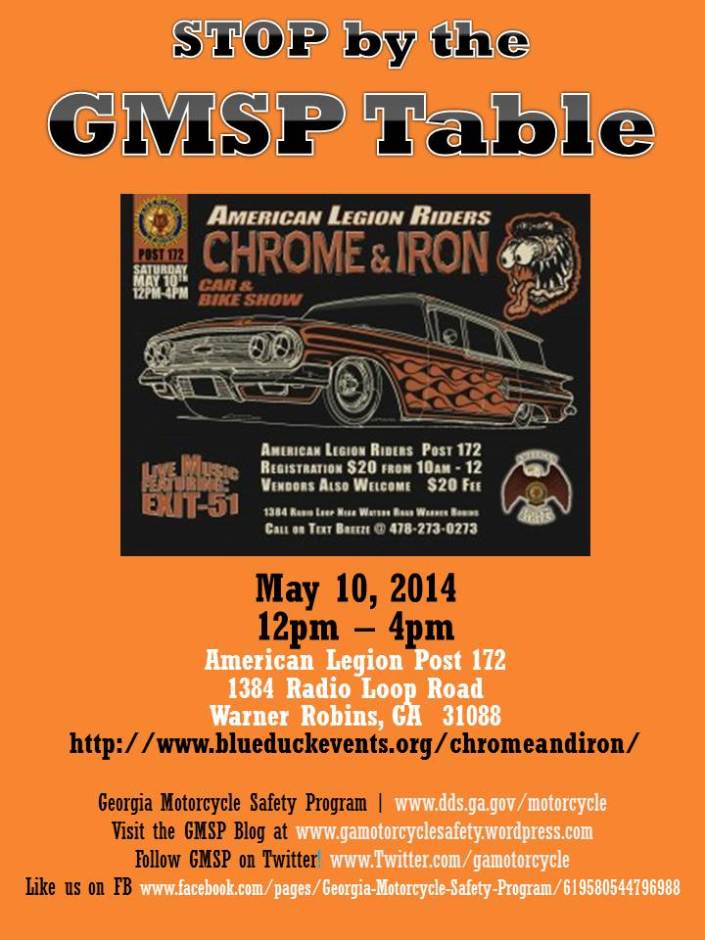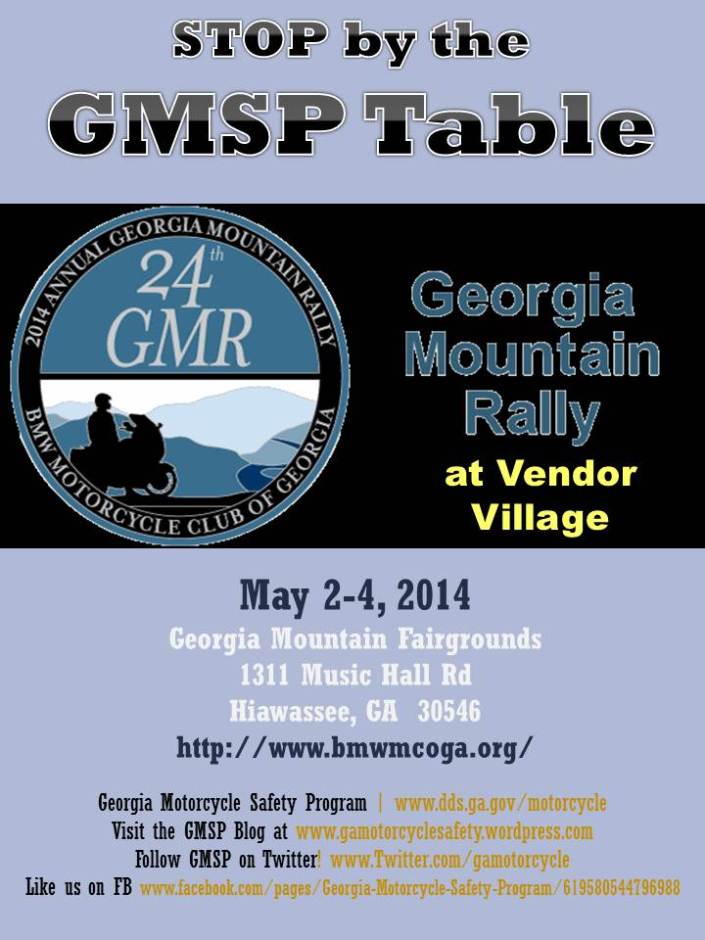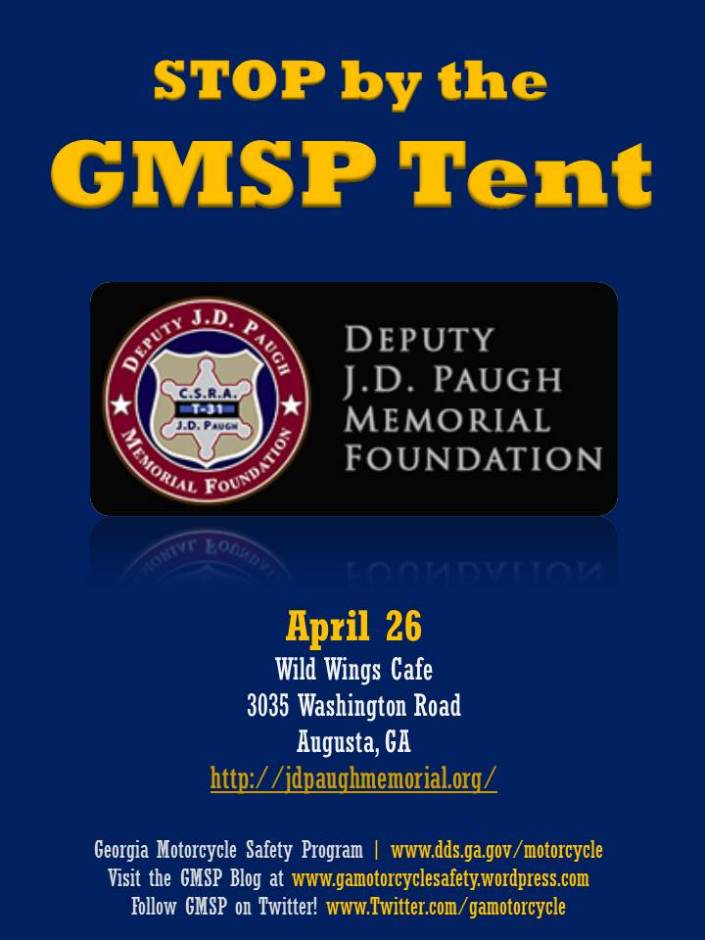GMSP
Join us at the GWRRA, chD Day in Cumming!
Image Posted on Updated on
This entry was posted in Home and tagged #MotorcycleSafety, #sharetheroad, american legion, basic riders course, BMW, buzzed driving, Cumming, DDS, drive sober, ERC, experienced rider course, georgia, GMSP, Gold Wing, GWRRA, GWRRA Chapter D, helmets, Hiawasee, motorcycle, motorcycle awareness, motorcycle awareness month, motorcycle helmet, motorcycle license, motorcycle procedures, motorcycle safety, motorcycle theft, motorcycle training, nhtsa, passenger safety, ride sober, ride sober or get pulled over, safety gear, share the road, take the course.
This entry was posted in Home and tagged #MotorcycleSafety, #sharetheroad, american legion, basic riders course, BMW, buzzed driving, DDS, drive sober, ERC, experienced rider course, georgia, GMSP, helmets, Hiawasee, motorcycle, motorcycle awareness, motorcycle awareness month, motorcycle helmet, motorcycle license, motorcycle procedures, motorcycle safety, motorcycle theft, motorcycle training, nhtsa, passenger safety, ride sober, ride sober or get pulled over, safety gear, share the road, take the course, warner robins.
GMSP at the BMW Mountain Rally!
Image Posted on Updated on
This entry was posted in Home and tagged #MotorcycleSafety, #sharetheroad, basic riders course, BMW, buzzed driving, DDS, drive sober, ERC, experienced rider course, georgia, GMSP, helmets, Hiawasee, motorcycle, motorcycle awareness, motorcycle awareness month, motorcycle helmet, motorcycle license, motorcycle procedures, motorcycle safety, motorcycle theft, motorcycle training, nhtsa, passenger safety, ride sober, ride sober or get pulled over, safety gear, share the road, take the course.
May is Motorcycle Awareness Month!
MOTORCYCLE SAFETY AWARENESS MONTH 2014
May is Motorcycle Safety Awareness Month, designed to encourage all drivers and motorc yclists to “share the road” with each other. Motorcyclist fatalities increased in 2012 to 4,957, accounting for 15 percent of total fatalities for the year. This increase in motorcycle fatalities continues a tragic trend over the last 15 years, which only saw a one-year decline in 2009. Crash-related motorcycle injuries also increased from 81,000 in 2011 to 93,000 in 2012. Safe riding practices and cooperation from all road users will help reduce the number of fatalities and injuries on our nation’s highways.
yclists to “share the road” with each other. Motorcyclist fatalities increased in 2012 to 4,957, accounting for 15 percent of total fatalities for the year. This increase in motorcycle fatalities continues a tragic trend over the last 15 years, which only saw a one-year decline in 2009. Crash-related motorcycle injuries also increased from 81,000 in 2011 to 93,000 in 2012. Safe riding practices and cooperation from all road users will help reduce the number of fatalities and injuries on our nation’s highways.
2014-MotorcycleSafetyAwaressMonth
- Road users should never drive, bike, or walk while distracted. Doing so can result in tragic consequences for everyone on the road, including motorcyclists.
- A motorcyclist has the same rights, privileges, and responsibilities as any other motorist on the roadway.
- Allow a motorcyclist a full lane width. Though it may seem as if there is enough room in a single lane for a motor vehicle and a motorcycle, looks can be deceiving. Do not share the lane: a motorcyclist needs room to maneuver safely.
- Because motorcycles are smaller than most vehicles, they can be difficult to see. Their size can also cause other drivers to misjudge their speed and distance.
- Size also counts against motorcycles when it comes to blind spots. Motorcyclists can be easily hidden in a vehicle’s blind spot. Always look for motorcycles by checking your mirrors and blind spots before switching to another lane of traffic.
- Always signal your intentions before changing lanes or merging with traffic. This allows motorcyclists to anticipate your movement and find a safe lane position.
- Don’t be fooled by a flashing turn signal on a motorcycle—it may not be self-canceling and the motorcyclist may have forgotten to turn it off. Wait to be sure the rider is going to turn before you proceed.
- Allow more distance – three or four seconds – when following a motorcycle; this gives the motorcycle rider more time to maneuver or stop in an emergency. Motorcycle riders may suddenly need to change speed or adjust lane position to avoid hazards such as potholes, gravel, wet or slippery surfaces, pavement seams, railroad crossings, and grooved pavement.
This entry was posted in Home and tagged #MotorcycleSafety, #sharetheroad, basic riders course, buzzed driving, DDS, drive sober, ERC, experienced rider course, georgia, GMSP, helmets, motorcycle, motorcycle awareness, motorcycle awareness month, motorcycle helmet, motorcycle license, motorcycle procedures, motorcycle safety, motorcycle theft, motorcycle training, nhtsa, passenger safety, ride sober, ride sober or get pulled over, safety gear, share the road, take the course.
This entry was posted in Home and tagged #DesignatedDriver, augusta, basic riders course, DDS, drive sober, ERC, ga, GMSP, helmets, motorcycle, motorcycle awareness, motorcycle helmet, motorcycle license, motorcycle procedures, motorcycle training, take the course.



